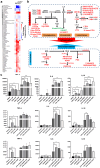Hepatic and extrahepatic metabolic modulation in hbv-related decompensated cirrhosis and acute-on-chronic liver failure
- PMID: 39312464
- PMCID: PMC11421379
- DOI: 10.1080/21505594.2024.2404953
Hepatic and extrahepatic metabolic modulation in hbv-related decompensated cirrhosis and acute-on-chronic liver failure
Abstract
Acute-on-chronic liver failure (ACLF) and decompensated cirrhosis (DC) are life-threatening syndromes that can develop at the end-stage of chronic hepatitis B virus (HBV) infection. Both ACLF and DC are complicated by hepatic and extrahepatic pathogeneses. To better understand the compartment-specific metabolic modulations related to their pathogenesis, HBV-DC, HBV-ACLF patients, and controls (30 each) were analyzed by metabolomics using portal (Port), hepatic vein (Hep), and peripheral (Peri) serum. Compartment ratios of metabolites (RatioHep/Port, RatioPeri/Hep, and RatioPort/Peri) were calculated. The liver tissues (10 per group) were analyzed using transcriptomics and metabolomics. An additional 75 patients with ACLF, 20 with DC, and 20 with liver cirrhosis (LC) were used to confirm oxlipid dysregulation. Both multi-omics datasets suggest suppressed energy, amino acid, and pyrimidine metabolism in the ACLF/DC liver. The serum metabolomic variations were contributed primarily by disease rather than sampling compartments, as both HBV-ACLF and HBV-DC patients demonstrated abnormal profiles of amino acids and peptides, indoles, purines, steroids, and benzimidazoles. In ACLF/DC patients, impaired hepatic metabolism resulted in a highly correlated hepatic and portal vein serum metabolome and release of inflammatory lipids and heme metabolites from the liver. HBV-ACLF showed higher RatioPeri/Hep of extrahepatic inflammatory oxlipids, while HBV-DC patients showed higher RatioPort/Peri of gut microbial metabolites. An inflammatory oxlipid outburst was confirmed in the early stages of HBV-ACLF. The inflammatory effects of the selected oxlipids were confirmed in monocytes. These findings support a synergy between liver-specific mechanisms and systemic inflammation in ACLF/DC development, and that pro-inflammatory oxlipids are metabolic signatures of early HBV-ACLF.
Keywords: Acute-on-chronic liver failure; HBV; decompensated cirrhosis; metabolomics; oxlipidomics.
Conflict of interest statement
No potential conflict of interest was reported by the author(s).
Figures






References
-
- Global HIV, Hepatitis and STIs Programmes (HHS) . Health Product Policy and Standards (HPS). Global hepatitis report 2024: action for access in low- and middle-income countries. Geneva: World Health Organization; 2024.
Publication types
MeSH terms
LinkOut - more resources
Full Text Sources
Other Literature Sources
Medical
